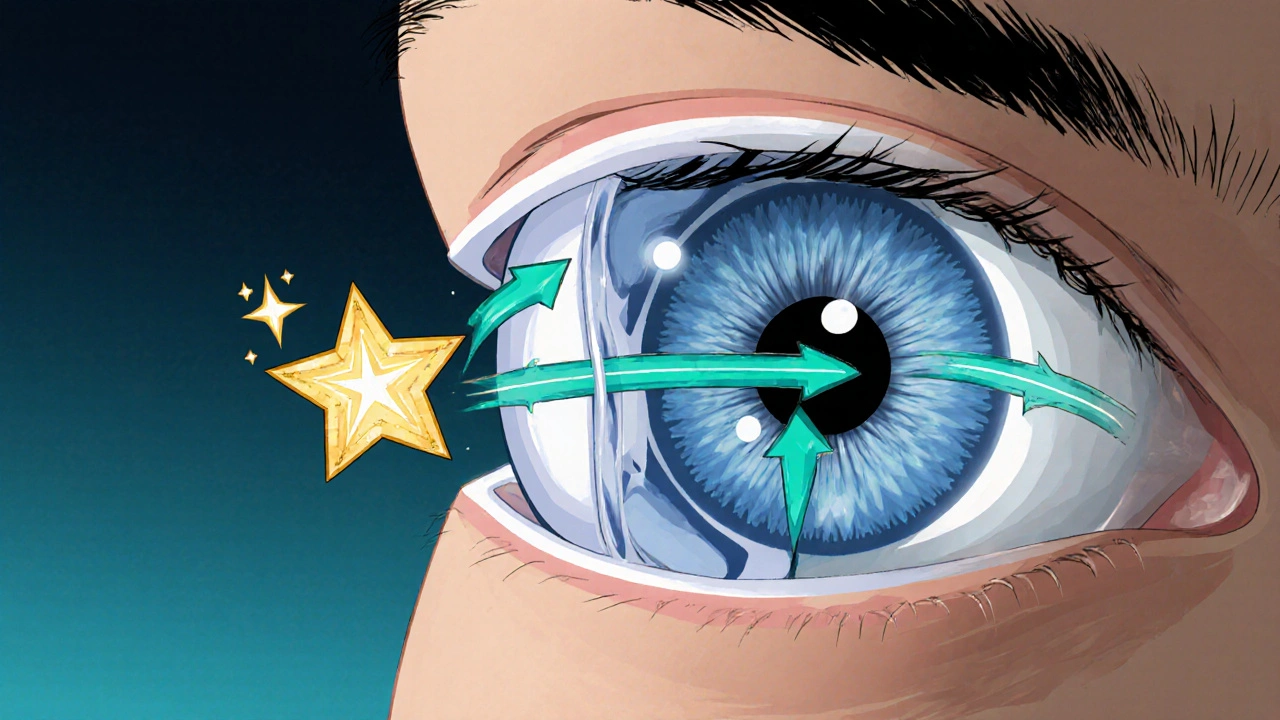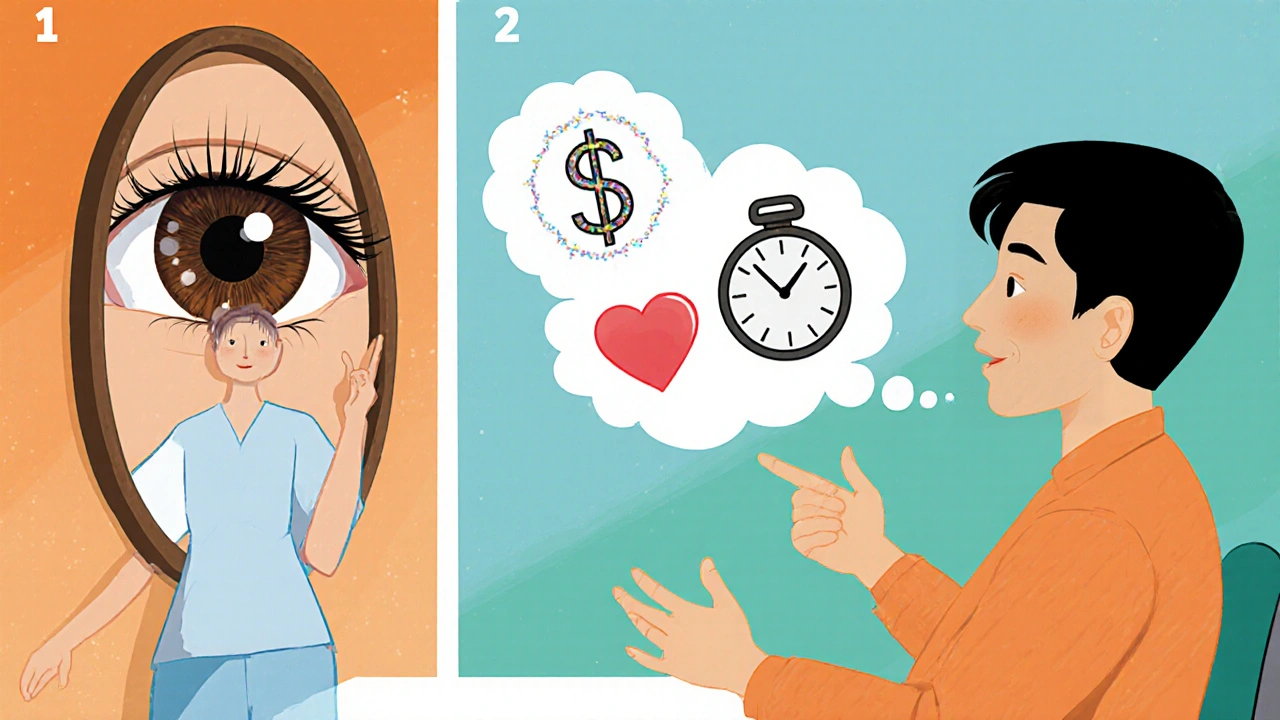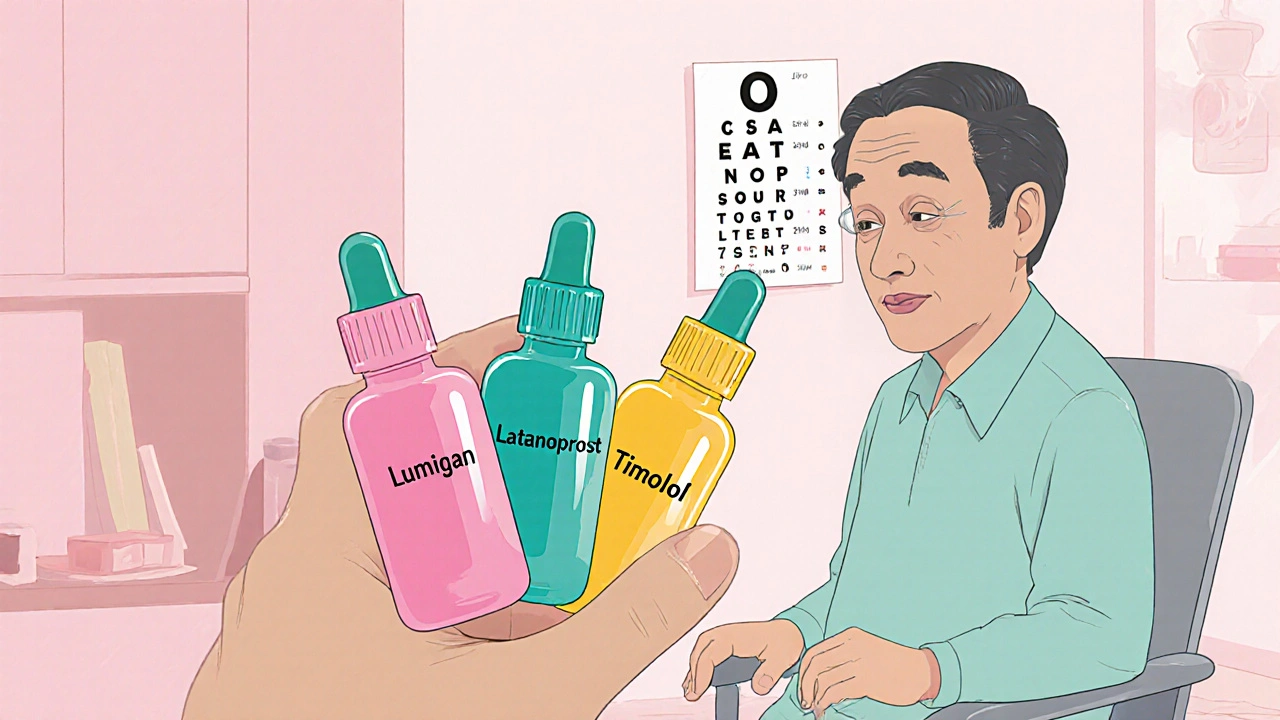Key Takeaways
- Lumigan (bimatoprost) provides the strongest average IOP reduction among single‑drop options.
- Lower‑cost alternatives like latanoprost and timolol work well for patients sensitive to prostaglandin side effects.
- Choosing the right eye drop depends on efficacy, side‑effect profile, dosing convenience and insurance coverage.
- Switching between drugs should be done under ophthalmologist supervision to avoid pressure spikes.
Lumigan is the brand name for bimatoprost, a prostaglandin analogue that lowers intra‑ocular pressure (IOP) in patients with open‑angle glaucoma or ocular hypertension. It was approved by the FDA in 2001 and quickly became a go‑to option for many eye specialists because of its powerful pressure‑lowering effect.
How Bimatoprost Works
Bimatoprost mimics the natural prostaglandin F2α molecule. It increases uveoscleral outflow - the pathway that drains fluid from behind the iris - allowing the eye to relieve pressure more efficiently. The result is typically a 25‑30 % drop in IOP after just one week of consistent use.
Common Alternatives to Lumigan
Several other eye drops hit the market with similar goals but different mechanisms, dosing schedules, or side‑effect patterns.
- Latanoprost - another prostaglandin analogue, often marketed as Xalatan. It reduces IOP by about 22‑26 % and is the cheapest generic option in many regions.
- Travoprost - brand name Travatan. Similar efficacy to latanoprost, but comes in preservative‑free formulations for patients with ocular surface disease.
- Timolol - a non‑selective beta‑blocker that lowers IOP by reducing aqueous humor production. Often combined with prostaglandins for additive effect.
- Dorzolamide - a carbonic anhydrase inhibitor that also cuts fluid production. Frequently prescribed when beta‑blockers are contraindicated.
- Brimonidine - an alpha‑2 agonist that both reduces fluid production and enhances outflow. Helpful for patients who need a lower‑pressure target.
- Prostaglandin analogues - the drug class that includes bimatoprost, latanoprost and travoprost. They share the same outflow‑enhancing mechanism but differ in potency and side‑effect profile.
- Beta‑blockers - a class represented by timolol. They act by slowing fluid production rather than increasing drainage.

Side‑Effect Snapshot
Every eye drop has trade‑offs. Below is a quick look at the most frequently reported adverse events for each drug.
- Lumigan - darkening of the iris, eyelash growth, conjunctival hyperemia.
- Latanoprost - similar iris pigmentation changes, but less pronounced eyelash effect.
- Travoprost - comparable to latanoprost; preservative‑free version reduces ocular surface irritation.
- Timolol - systemic fatigue, bronchospasm in asthma patients, possible heart rate slowdown.
- Dorzolamide - metallic taste, occasional stinging after instillation.
- Brimonidine - dry mouth, allergic conjunctivitis, rare central nervous system effects.
Head‑to‑Head Comparison
| Drug | IOP Reduction (average) |
Typical Dose | Common Side Effects | Annual Cost (US) |
|---|---|---|---|---|
| Lumigan | 28‑30 % | 1 drop nightly | iris darkening, eyelash growth, redness | $600‑$900 (brand); $200‑$300 (generic) |
| Latanoprost | 22‑26 % | 1 drop nightly | iris hyperpigmentation, mild redness | $30‑$80 (generic) |
| Travoprost | 24‑28 % | 1 drop nightly | similar to latanoprost, less irritation (preservative‑free) | $100‑$150 (brand); $40‑$70 (generic) |
| Timolol | 20‑25 % | 1 drop BID | fatigue, bronchospasm, bradycardia | $15‑$40 (generic) |
| Dorzolamide | 15‑20 % | 1 drop TID | metallic taste, stinging | $25‑$60 (generic) |
| Brimonidine | 18‑22 % | 1 drop TID | dry mouth, allergic conjunctivitis | $30‑$70 (generic) |

Factors to Consider When Picking an Eye Drop
Below is a decision‑making checklist you can run through with your eye doctor.
- Target IOP reduction: If you need the deepest drop, Lumigan or Travoprost are top performers. \n
- Side‑effect tolerance: Patients who mind iris darkening often switch to latanoprost or a non‑prostanoid.
- Systemic health: Asthma or heart disease may rule out beta‑blockers like timolol.
- Cost & insurance: Generic prostaglandins (latanoprost) are typically covered at a lower co‑pay.
- Dosing convenience: Once‑daily drops improve adherence compared with BID or TID regimens.
Practical Tips for Using Glaucoma Eye Drops
- Wash your hands and avoid touching the tip of the bottle.
- Pull down the lower eyelid to create a small pocket.
- Let the drop fall without squeezing the bottle.
- Close your eye gently for about one minute; press the inner corner (punctal occlusion) to reduce systemic absorption.
- Wait at least five minutes before applying another medication to prevent wash‑out.
If you’re switching from one prostaglandin to another, keep a weekly IOP log for the first month. A sudden rise may signal the need for a supplemental drug.
Frequently Asked Questions
Can I use Lumigan and latanoprost together?
Combining two prostaglandins offers little extra benefit and raises the risk of pigmentary changes. Doctors usually pair a prostaglandin with a beta‑blocker or carbonic anhydrase inhibitor instead.
Why does my iris look darker after starting Lumigan?
Bimatoprost stimulates melanin production in the iris stroma. The change is permanent in the treated eye and harmless, but it can be unsettling if you have light-colored eyes.
Is it safe to stop my eye drops once my pressure is under control?
Glaucoma is a chronic disease; stopping medication usually leads to pressure rebound. Talk to your ophthalmologist before making any changes.
What if I’m allergic to the preservative in my drops?
Preservative‑free formulations like Travoprost PF or preservative‑free timolol exist. Discuss alternatives with your doctor.
Do these eye drops affect my vision quality?
They don’t improve vision but they help protect the optic nerve by keeping pressure low. Some patients notice temporary blur right after instillation, which usually clears in a few minutes.
In short, Lumigan remains a powerhouse for aggressive pressure control, but cost, cosmetic side effects, and personal health conditions often tip the scales toward a cheaper prostaglandin or a complementary class. Always involve your eye specialist in the decision‑making process to find the safest, most effective regimen for your eyes.


8 Comments
The pharma giants love to push Lumigan as the "ultimate" drop, but have you ever wondered why they hide the cheaper prostaglandins behind a veil of marketing hype? They want us to think only the most expensive brand can control pressure, while a simple generic can do the job. This is not just about money; it's about controlling the narrative of ocular health. The truth is buried deep, like the fluid they claim to drain, and only the vigilant will see through the fog. Remember, every drop carries a hidden agenda.
Eye drops paint your eyes with colors you never asked for.
Listen up, folks! If you need a drop that knocks pressure out like a heavyweight champ, Lumigan is the beast you want. But don’t forget, consistency beats occasional power, so stick to the regimen like a drill sergeant. Talk to your doc, test the waters, and don’t settle for anything less than your target IOP. Let’s get those numbers down and keep the optic nerve safe!
Great points on staying consistent. It’s also helpful to track your IOP weekly for the first month after any switch. If you notice spikes, let your ophthalmologist adjust the plan promptly.
When I first tried Lumigan, the darkness settled into my iris like midnight creeping over a quiet lake. The lashes grew, whisper‑like feathers framing each stare. Yet the price felt like a toll road you can’t afford without a heavy wallet. Sometimes I wonder if the drama of pigment change is worth the pressure drop.
From an Indian perspective, the cost factor is massive – many cant afford brand name drops. Generic latanoprost offers a respectable drop in pressure without breaking the bank. Also, preservative‑free options are great for those with sensitive eyes. Remember, health equity matters, so discuss budget options with your doctor.
The cultural nuance of eye‑care is often overlooked, but patients value traditions of holistic health. Mixing modern drops with traditional eye rinses can be safe if you check with a professional. Balance is key.
Agree, balance is essential and a simple regimen helps adherence It’s good to know options exist without overwhelming the patient
Write a comment